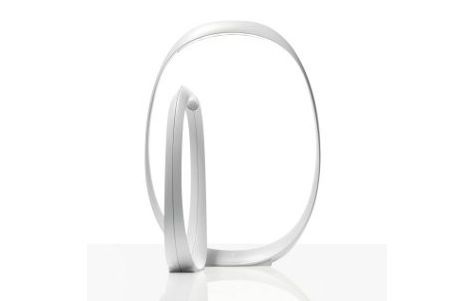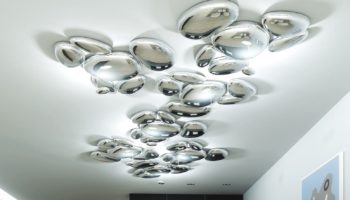Anisha Light by Lievore Altherr Molina for Foscarini
It’s rare that a table lamp hits me as an elegant work of art. Normally, they’re mechanically-based, functional task lights that blend into the office surroundings, or tall and bulbous bases with an off-white lampshade. In the case of Lievore Altherr Molina‘s new Anisha lamp for Foscarini, I’ll gladly eat my generalized table lamp words. This, my friends, is an illuminated sculpture.
Anisha. Designed by Lievore Altherr Molina. Manufactured by Foscarini.
The Round Anisha Lamp in Red or White Redefines the Shape of a Table Light
“Like a fluid and enveloping frame, an irregular ellipse that gives a sense of becoming, Anisha outlines an empty space, defines it and fills it with its light, producing a magical sensation,” describes Lievore Altherr Molina of the contour line of light that has been formed into a circle. Anisha is created in two colors that demand different types of attention. According to the product description by Foscarini, the white “blends with the space” while the red creates a “decisive, recognizable presence”.

If the circular design itself doesn’t confuse a person upon first spotting the contemporary spin of a table lamp, perhaps it is the way the light exudes from its center. Made from ABS, the Anisha table lamp is great for any setting or environment, shining its light out from the center as if the LEDs within were eager to burst through its central seam. .

The large, or grande, version of Anisha measures 13″W x 2″D x 18-1/8″H and uses a 4.5-watt LED bulb. In the smaller version, known as the piccolo, the measurements are 9-1/16″W x 2″D x 12-5/8″H with a 3.4-watt LED bulb

Best said on the Foscarini website as a lamp to be used “in the entrance, in a lounge, bedroom or on a desk, with its light spirit and unmistakable identity: both on and off.”
About the Manufacturer: Helmed by Alessandro Vecchiato and Carlo Urbinati, the lighting manufacturer Foscarini has, in just 27 short years, managed to reach the top of this design sector. Foscarini’s singular contributions to lighting are a result of deep immersion and emotional investment—sentiments that fuel everything the company does. Among researchers, product designers, and even collaborating architects and interior designers, emotion is the driving force behind each and every product and project.




Leave a Reply